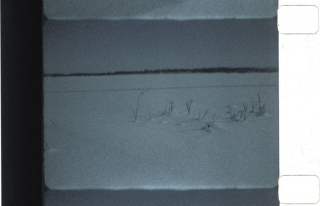Date: 28 October 2007 | Season: London Film Festival 2007 | Tags: London Film Festival
OVER LAND AND SEA
Sunday 28 October 2007, at 2pm
London BFI Southbank NFT3
Patrick Beveridge, The Ivalo River Delta, UK, 2007, 17 min
Shot within the Arctic Circle in northern Lapland, the film documents the landscape and lively night sky of an icy wilderness. The Aurora Borealis and other extraordinary phenomena are captured through long exposures and stunning time-lapse photography.
Peter Hutton, At Sea, USA, 2007, 60 min
Peter Hutton has modestly spoken of his work as being ‘a little detour’ from the history of cinema but perhaps he is following a path that others have neglected, or are yet to discover. Typified by fixed shots of extended duration, his concentrated gaze builds a bridge between early cinema, landscape painting and still photography, evoking Lumière, Turner and Stieglitz. Hutton’s camera often records the subtle changes of light and atmospheric conditions of rural and urban locations, and has frequently been directed toward nautical themes. This new film is essentially about the birth, life and death of large merchant ships. Following the construction of the vessels in South Korea and the passage of a massive container ship across the North Atlantic, it ends with images of shipbreaking in Bangladesh. At Sea is a real tour-de-force, in which the weight and scale of its subject is conveyed by masterful cinematography over a series of breathtaking compositions.
Peter Hutton will present a screening of his early work at Tate Modern on Monday 29 October 2007.
PROGRAMME NOTES
OVER LAND AND SEA
Sunday 28 October 2007, at 2pm
London BFI Southbank NFT3
THE IVALO RIVER DELTA
Patrick Beveridge, UK, 2007, 16mm, colour, silent, 17 min
The title of this film refers to the landscape where it was shot – an open marshland in northernmost Finland. This terrain, which is covered in thick snow during the winter months, provided a surface for filming changes in nocturnal light that are in response to the movement and position of the moon, and the sporadic displays of the polar lights. Such a project inadvertently raises the problem of landscape film as a genre in its own right. However, the film also has elements of astronomical and atmospheric photography. In particular, some experiments using film cameras placed on rotating celestial mounts lead to the unpredicted outcome of both the earth and the sky staying in focus with prolonged exposure for each frame. The film has a number of tracking shots, assembled in the chronological order they were taken, that document the events of particular nights. In filming above the horizon the camera moved with the stars across the northern sky. Against this backdrop displays of the polar lights occurred on clear nights, of which, during the unusually warm winter of 2005, there were few. (Patrick Beveridge).
AT SEA
Peter Hutton, USA, 2007, 16mm, colour, silent, 60 min
Films by Peter Hutton appear more closely related to landscape painting and still photography than contemporary cinema. In their stately portrayal of urban and rural locations, they afford the viewer a rarefied and highly-focused mode of looking, a stillness seemingly at odds with everyday life. Over shots of extended duration, the world reveals itself before the camera, which often records only subtle changes of light and atmospheric conditions. Peter Hutton began making films in 1970 and has work in the collections of the Whitney Museum, Centre Georges Pompidou and the Austrian Film Museum. A former merchant seaman, he has been a professor of film at Bard College in the Hudson River Valley since 1985. (Mark Webber)
Put simply, the film tells the story (‘the birth, life and death’, in the director’s words) of a container ship – but there are no words to adequately describe the film’s awesome visual expedition. Hutton knows the sea. His experiences as a former merchant seaman have informed his filmmaking practice, known for its rigour and epic beauty. At Sea begins in South Korea with diminutive workers shipbuilding. The colossal vessel is revealed in de Chirico-worthy proportions, its magnitude surreal to the human eye. Off to sea, the splendour and intensity of the water – set against the vibrant colours of the containers – causes us to see the world anew. The film concludes in Bangladesh amidst shipbreakers as enthralled by Hutton’s camera as we are by his images. (Andréa Picard, Toronto International Film Festival)
Back to top
